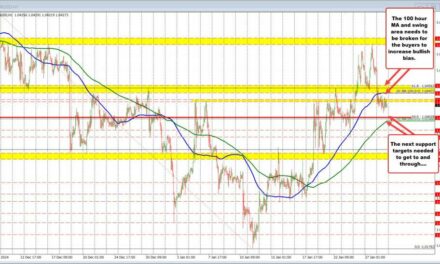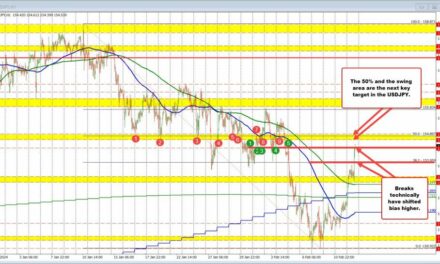The US dollar strengthened following a stronger-than-expected nonfarm payroll report, which showed a gain of 147K jobs, well above the 110K estimate. The unemployment rate also improved, falling to 4.1% from 4.3%. However, average hourly earnings were softer, rising 0.2% month-over-month (vs. 0.3% expected) and 3.7% year-over-year (vs. 3.9% expected).
One notable caveat: government hiring accounted for nearly half the total job gains, with 73,000 positions added, primarily at the state and local levels.
A quick look at the technical picture across major currency pairs reveals the following:
EURUSD: The EURUSD broke below its 100-hour moving average at 1.1768, signaling a more bearish tone, while still holding above the 200-hour moving average at 1.16075, with the session low reaching 1.17163. Notably, the pair also fell below yesterday’s low at 1.1746 and last week’s high at 1.17529, both of which now act as near-term resistance. Yesterday’s bounce held at the 100-hour MA, so today’s move below it strengthens the bearish bias, and sellers will look to defend these broken levels to maintain short-term control.
- The USDJPY moved sharply higher, breaking above both its 100- and 200-hour moving averages following a stronger-than-expected US jobs report. The 100-hour MA, at 143.904, offered little resistance, and the pair quickly cleared the 200-hour MA at 144.567 as well. Momentum carried the price through the 50% retracement of the move up from the May 27 low, which sits at 145.06. The pair is currently trading around 145.20, signaling growing bullish control. On further upside, resistance targets come in at 145.47 and 145.76. Buyers remain control as long as price stays above broken resistance levels with the 200 moving average at 144.56 a key support.:
- GBPUSD: The GBPUSD dropped sharply following the US jobs report, breaking below key technical levels including the 38.2% retracement of the June low to end-of-month high at 1.3628, as well as the swing area between 1.3615 and 1.3633—both of which now act as near-term resistance. A move back above those levels would likely frustrate sellers and could trigger short covering. On the downside, the price found support just above the 50% midpoint of the June trading range at 1.35786. Notably, yesterday the pair briefly dipped below that midpoint to 1.35618 before rebounding strongly and rallying toward swing highs earlier today, only to reverse lower again on the back of the stronger data. Getting below the 50% midpoint and the low from yesterday would have traders looking toward 1.35292 (61.8% retracement level).
- USDCHF: The USDCHF pushed higher, breaking above its 100-hour moving average at 0.7938 and moving past last week’s low at 0.7957, which now serves as close support for buyers looking to maintain upside momentum. On the topside, key resistance comes in at the 38.2% retracement of the decline from the June 19 high at 0.8002, with the falling 200-hour moving average just below at 0.7999. A break above the 0.8000 level would be a significant bullish signal, opening the door for buyers to take firmer control.
ForexLive.com
is evolving into
investingLive.com, a new destination for intelligent market updates and smarter
decision-making for investors and traders alike.







